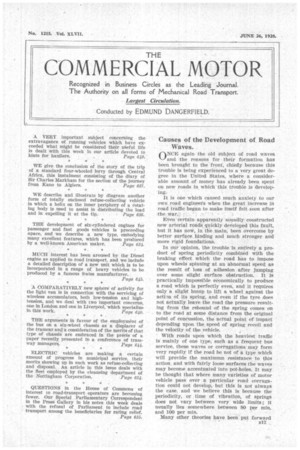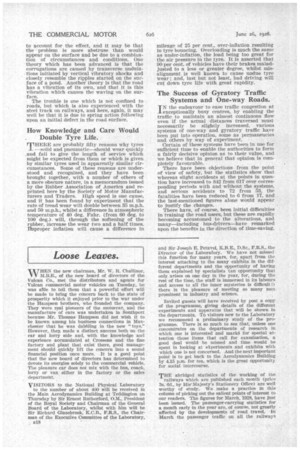Causes of the Development of Road Waves.
Page 43

Page 44

If you've noticed an error in this article please click here to report it so we can fix it.
ONCE again the old subject of road waves Wand the reasons for their formation has been brought to the front, chiefly because this trouble is being experienced to a very great degree in the United States, where a considerable amount of money has already been spent on new roads in which this tronble is developing. It is one which caused much anxiety to our own road engineers when the great increase in road traffic began to make itself felt soon after the war. '
Even• certain apparently soundly constructed new arterial roads, quickly developed this fault, but it has now, in the main, been overcome by better surface binding and much stronger and more rigid foundations.
In our opinion, the trouble is entirely a product of spring periodicity combined with the braking effect which the road has to impose upon wheels spinning at an abnormal speed as the result of loss of adhesion after jumping over some slight surface obstruction. It is practically impossible economically to produce a road which is perfectly even, and it requires only a slight hump to lift a wheel against the actiln of its spring, and even if the tyre does not actually leave the road the pressure resulting from the rebound of the spring comes on to the road at some distance from the original point of concussion, the actual point of impact depending upon the speed of spring recoil and the velocity of the vehicle.
With roads upon which the heaviest traffic Is mainly of one type, such as a frequent bus service, these waves or corrugations may form very rapidly if the road be not of a type which will provide the maximum resistance to this• action and with fairly loose surfaces the waves may become accentuated into pot-holes. It may be thought that where many varieties of motor vehicle pass over a particular road corrugation could not develop, but this is not always the case. and •we believe this is because the periodicity, or time of vibration, of springs does not vary between very wide limits; it usually lies somewhere between 80 per min. and 100 per min.
Many other theories have been put forward B17, , to account for the effect, and it may be that the problem is more abstruse than would appear on the surface and be due to a combination of circumstances and conditions. One theory which has been advanced is that the corrugations are caused by transverse undulations initiated by vertical vibratory shocks and closely resemble the ripples started on the surface of a pond. Another theory is that the road has a vibration of its own, and that it is this vibration which causes the waving on the surface.
The trouble is one which is not confined to roads, but which is also experienced with the steel track on railways, and here, again, it may well be that it is due to spring action following upon an initial defect in the road surface.
How Knowledge and Care Would Double Tyre Life.
frHERE are probably fifty reasons why tyres .1_ —solid and pneumatic—should wear quickly and fail to give the length of service which might be expected from them or which is given by similar tyres used in apparently similar circumstances. Some of these reasons are understood and recognized, and they have been brought together, with a number of others of a more obscure nature, in a memorandum issued by the Rubber Association of America and reprinted here by the Society of Motor Manufacturers and Traders. High speed is one cause, and it has been found by experiment that the rate of tread wear will double between 35 m.p.h. and 50 m.p.h., whilst a difference in atmospheric temperature of 40 deg. Fahr. (from 60 deg. to 100 deg.). will, through the softening of the rubber, increase the wear two and a half times. rinproper inflation will cause a difference in mileage of 25 per cent., over-inflation resulting In tyre bouncing. Overloading is much the same as under-inflation, the load being too great for the air pressure in the tyre. It is asserted that 90 per cent, of vehicles have their brakes maladjusted to a less or greater degree, whilst misalignment is well known to cause undue tyre wear ; and, last but not least, bad driving will cut clown tyre life with great rapidity.
The Success of Gyratory Traffic Systems and One-way Roads.
IN the endeavour to ease traffic congestion at exceptionally buSy centres, by enabling the traffic to maintain an almost continuous flow even if the actual distances traversed must necessarily be slightly increased, various systems of one-way and gyratory traffic have been put into operation, some as perraaneucies and others by way of experiment.
Certain of these systems have been in use for sufficient time to enable the authorities to form a fairly decisive opinion as to their value, and we believe that in general that opinion is completely favourable. There have been objections from the point of view of safety, but the statistics show that whereas slight accidents at the points in question have increased to 842 from 617 over corresponding periods with and without the systems, and serious accidents to 72 from 53, the fatalities have been reduced to 6 from 17, and the last-mentioned figures alone would appear to justify the changes.
There have, of course, been initial difficulties in training the road users, but these are rapidly becoming accustomed to the alterations, and many—including bus-drivers—have remarked upon the benefits in the direction of time-saving.




















































































































